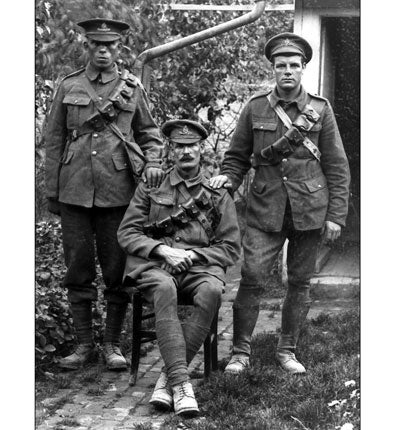Images rescued from dump reveal black British 'Tommy' at the Somme
John Lichfield sifts through remarkable archive photographs capturing the brotherhood of men at arms

At first glance, there may seem to be nothing unusual about this photograph, rescued from a rubbish skip in northern France.
Look, though, at the British soldier on the left. He is black: a very rare example of an image of a black "Tommy" from the First World War.
The photograph is one of almost 400 snaps of British soldiers on the eve of, and during, the Battle of the Somme in 1916. The trove has been rescued from oblivion by two French men. Many of the images are published in today's Independent magazine for the first time. The photographs, all of which are preserved on glass plates, lay undisturbed in the attic of a ramshackle barn 10 miles behind the Somme battlefields for more than 90 years.
When the barn changed hands in 2007, they were thrown on to the street. Passers-by collected a few and eventually the historical value of the plates, some in perfect condition, some badly damaged, was realised.
In recent months they have been assembled and their images printed, scanned and digitally restored by two local men, Bernard Gardin and Dominique Zanardi. M. Gardin, 60, is a photography enthusiast, while M. Zanardi, 49, owns the "Tommy" cafe, which sits in the heart of the Somme battlefield in the village of Pozières.
An amateur photographer, possibly a local farmer, is believed to have taken the photographs in the winter of 1915-16 and the spring and summer of 1916. The unknown photographer presumably made a crust by charging British soldiers a few francs to take a snap which they could send home to their loved ones.
The lovingly-assembled collection forms a poignant record of the British army on the eve of, or during the Battle of the Somme: the most murderous single battle of the 1914-18 war in which 400,000 British and empire soldiers died. The identity of the soldiers is, and may always remain, a mystery. They are, in a sense, a photographic parallel to the 400 unknown British and Australian soldiers whose bodies are being excavated from eight mass graves near Fromelles, 50 miles to the north.
There are several gems among the photographs, including one shot of a soldier who is almost seven feet (2.13m) tall, sitting next to his more conventionally-sized comrades.
The most startling, and historically most significant, may be this image of a black Tommy in a pose of relaxed friendship with two white comrades. There was a small black community in Britain in the period of 1914 to 1918, estimated at 20,000 people, mostly living at sea ports, from London to Liverpool, Cardiff and Salford.
Black Britons are known to have volunteered and fought on the Western Front but photographs of them are extremely rare. The British First World War historian, Michael Stedman, the author The Salford Pals and The Manchester Pals, has identified the three soldiers in the photograph as members of the Royal Regiment of Artillery or Royal Garrison Artillery.
"Look at the chalk dust on their boots and general cleanliness of their kit," he explains. "Chalk dust only arose in the summer campaigning on the 1916 Somme battlefield as the terrain dried out. My bet is that this photo was taken in the summer of 1916 (probably August/September).
"The men look worn, gaunt, frayed and very fit and lean, from relatively little food and an open air existence. I suspect they have been in action for some time ... They are clearly friends – hands on shoulders and all that."
There were West Indian and Gold Coast (Ghanaian) units in the fighting on the Western Front but the story of black British soldiers scattered in otherwise white frontline units has been sparsely recorded.
Relations between white and black soldiers were reported to have been good although there was a riot – fomented by white South Africans – between white and black soldiers recovering from their wounds at a hospital in Liverpool in 1918.
In this image, though, there is none of that potential for animosity visible: only the natural brotherhood of three men thrown together by a brutal war, and relying on each other to survive.
Join our commenting forum
Join thought-provoking conversations, follow other Independent readers and see their replies
Comments